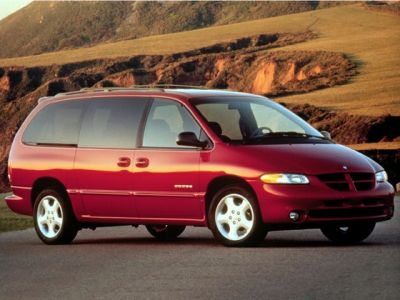 1996 Plymouth Voyager II Dimensions, Size & Specs
1996 Plymouth Voyager II Dimensions, Size & SpecsMeasurements of the 1996 Plymouth Voyager II, engineered for optimal performance and comfort
| Dimensions | |
|---|---|
| Length: | 4733 mm186.3 in15.5 ft |
| Width: | 1920 mm75.6 in6.3 ft |
| Height: | 1740 mm68.5 in5.7 ft |
| Trunk Capacity: | 450 liter15.9 cu ft |
| Trunk Capacity (Max): | 4140 liter146.2 cu ft |
| Weight Specifications | |
| Curb Weight: | 1600-1605 kg3527-3538 lbs |
| Tire Specifications | |
| Tire Sizes: |
|
The 1996 Plymouth Voyager II represents the second generation minivan from Plymouth, produced from 1996 to 2000. Designed as a family-friendly vehicle, this minivan features a length ranging from 4730 mm to 4733 mm (186.2 - 186.4 inches), a width of 1920 mm (75.6 inches), and a height of 1740 mm (68.5 inches). These dimensions provide the Voyager II with a balanced profile suitable for comfortable urban and suburban driving.
Curb weight varies slightly between 1600 kg and 1605 kg (3527 - 3540 lbs), reflecting the solid build quality typical of minivans from this era. This weight contributes to the vehicle's stable road presence without compromising maneuverability.
One of the standout features of the Plymouth Voyager II is its flexible cargo space. With rear seats in place, the luggage compartment offers 450 liters (15.9 cubic feet) of storage, ideal for everyday family needs such as groceries or sports gear. Folding down the rear seats vastly increases available cargo volume to an impressive 4140 liters (146.2 cubic feet), accommodating much larger items and enhancing versatility for travelers and tradespeople alike.
The Voyager II is equipped with tire sizes 205/75 R14 S, 205/75 R14, and 215/65 R15, catering to different driving preferences and load requirements while maintaining good road grip and ride comfort.
In summary, the 1996 Plymouth Voyager II is a midsize minivan offering a spacious interior, practical cargo solutions, and a robust presence on the road. Its combination of moderate length, width, and height makes it a competitive choice among minivans of the late 1990s, balancing passenger comfort with cargo utility effectively.
Discover the standout features that make the 1996 Plymouth Voyager II a leader in its class
Have a question? Please check our knowledgebase first.
The Plymouth Voyager II, produced from 1996 to 2000, has a length ranging between 4730 mm and 4733 mm, which translates to approximately 186.2 inches to 186.4 inches. This length positions the Voyager II comfortably in the minivan category, offering a balance between interior space and maneuverability. The slight variation in length can be attributed to different trim levels or manufacturing tolerances during the vehicle's production years.
The width of the Plymouth Voyager II is 1920 mm, equivalent to about 75.6 inches. This width gives the minivan a spacious feel for passengers, especially in the front and middle rows, enhancing comfort during travels. Additionally, this width ensures better stability on the road, especially during cornering or inclement weather, without making the vehicle overly bulky for standard traffic lanes.
The height of the Plymouth Voyager II is 1740 mm or approximately 68.5 inches. This height provides ample headroom inside the vehicle, contributing to passenger comfort. Regarding aerodynamics, while taller vehicles like minivans typically have more air resistance than sedans, the Voyager II's design aimed to balance interior space with reasonable aerodynamic performance. However, the height might present a challenge in low-clearance parking garages or multi-story parking structures.
The curb weight of the Plymouth Voyager II ranges between 1600 and 1605 kg, which converts to roughly 3527 to 3539 pounds. This weight includes the vehicle with standard equipment and all necessary fluids but without passengers or cargo. It reflects the robust construction of the minivan, contributing to safety and stability, while also impacting fuel efficiency and handling dynamics typical of vehicles in this class.
The Plymouth Voyager II offers a luggage capacity of 450 liters (approximately 15.9 cubic feet) when all rear seats are in place. This space is ideal for daily errands or small trips, accommodating suitcases and smaller parcels. When the rear seats are folded down, the luggage space dramatically increases to 4140 liters, or about 146.2 cubic feet, offering significant cargo volume for transporting larger items, furniture, or bulk groceries, a key benefit of minivans for versatile usage.
The Plymouth Voyager II can be equipped with tire sizes 205/75 R14 S, 205/75 R14, and 215/65 R15. The 205/75 R14 tires provide a higher sidewall profile, which helps offer a smoother ride by absorbing bumps effectively. The 215/65 R15 tires, being slightly wider with a lower profile, can enhance handling responsiveness and cornering stability. The choice of tire size affects grip, ride comfort, and overall driving dynamics, allowing owners to select options based on personal preferences and driving conditions.
The Plymouth Voyager II's dimensions—approximately 4730 mm (186.2 inches) in length, 1920 mm (75.6 inches) in width, and 1740 mm (68.5 inches) in height—generally allow it to fit into most standard residential garages, which typically accommodate vehicles up to about 6 meters (19.7 feet) in length and 2.4 meters (7.9 feet) in width. However, due to its relatively taller height compared to sedans or compact cars, owners should verify the garage's vertical clearance, which is usually around 2.1 to 2.3 meters (6.9 to 7.5 feet), to ensure the vehicle comfortably fits without risk of damage.
The Plymouth Voyager II, produced from 1996 to 2000, showed noticeable evolution from the first-generation Voyager in both size and design. It maintained a similar minivan footprint but introduced a slightly longer and wider body, offering improved interior space and passenger comfort. Design-wise, the Voyager II featured a more aerodynamic and modern aesthetic with updated front and rear fascias, better safety features, and refined ergonomics. These changes resulted in a more practical and comfortable vehicle while maintaining the versatility that defined the first generation.
The Plymouth Voyager II was competitive in size and features when compared to similar mid-to-late 1990s minivans like the Dodge Caravan and Chrysler Town & Country. Its dimensions were on par, with length around 4730 mm and width near 1920 mm, offering equivalent interior space. The Voyager II was known for generous cargo capacity—up to 4140 liters with seats folded—which rivaled or exceeded many competitors. Features such as multiple tire size options and seating flexibility made it a versatile family vehicle. Additionally, its weight and size contributed to solid road presence and stability, a common expectation in this vehicle category.
Potential buyers of the Plymouth Voyager II should consider its substantial length (around 4730 mm or 186.2 inches) and width (1920 mm or 75.6 inches), which provide excellent interior room and cargo capacity but require attention when maneuvering in tight urban spaces. Parking may be challenging in compact city spots or crowded parking lots due to its minivan size. However, the relatively moderate height of about 1740 mm (68.5 inches) helps with vertical clearances in garages and parking structures. Overall, users should weigh the convenience of spaciousness against the need for cautious driving in constrained environments.
Discover similar sized cars.

| Production: | 1996-2000 |
|---|---|
| Model Year: | 1996 |
| Length: | 4733 mm186.3 in |
| Width: | 1920 mm75.6 in |
| Height: | 1740 mm68.5 in |
